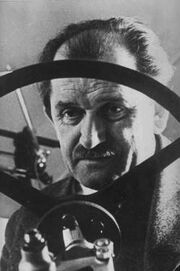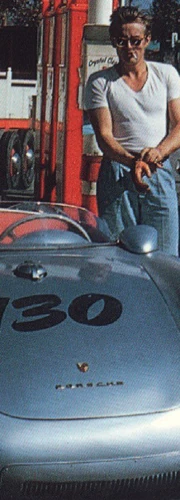
Ferdinand Porsche
Prof. Dr. h.c. Ferdinand Porsche (September 3, 1875 – January 30, 1951) was an Austrian automotive engineer. Porsche was born to a German speaking family in Maffersdorf (Vratislavice nad Nisou), in the Sudetenland part of former Austria-Hungary. His birthplace is now assigned to the district of Liberec in present-day Czech Republic. Porsche is best known for designing the original Volkswagen Beetle and for his contributions to advanced German tank designs: Tiger I, Tiger II and the Elefant. Adolf Hitler honored Porsche in 1937 when he was awarded the German National Prize for Art and Science, one of the rarest decorations in the Third Reich.
Porsche's son, Ferry Porsche, is the eponym for Porsche automobiles, initially based to a large extent on the Volkswagen (Beetle) design (sometimes, the car type also is mistakingly called "bug", though that insect is rather flat and edgy instead of showing the popular rounded shape - possibly, because the beetle most think of is called ladybug).
The name Porsche is pronounced with an audible "e" in German, "PORSH-uh", not "PORSH". It might be related to Czech "Boreš" [boresh] (or vice versa).
Porsche showed high aptitude for mechanical work at a very young age. He managed to attend classes at the Imperial Technical School (today a Czech Gymnasium) in Liberec at night while helping his father in his mechanical shop by day. Thanks to a referral, Porsche landed a job with Bela Egger in Vienna when he turned 18. In Vienna he would sneak into the local University after work whenever he could. Beyond auditing classes there, Porsche had never received any higher engineering education.
After five years with Bela Egger, Porsche joined the local carriage factory Jakob Lohner & Co. He felt attracted to the nascent automotive industry and Jakob Lohner began construction of automobiles in 1896 under Ludwig Lohner in the trans-Danubian suburb of Floridsdorf, today eponym of Vienna's 21st district.
Their first design, unveiled in 1898, was the "System Lohner-Porsche", a carriage powered by an internal combustion engine with a series-hybrid drive train composed of four wheel-mounted electric motors. They presented the car on the Exposition Universelle 1900 World Exhibition in Paris. The up to 56 km/h (35 mph) fast carriage broke several Austrian speed records, and also won the Exelberg Rally in 1901 with Porsche himself driving. It was later upgraded with more powerful engines from Daimler and Panhard, which proved to be enough to post more speed records. Over 300 of the Lohner-Porsche carriages were sold to the public. In 1905, Porsche was recognized with the Poetting prize as Austria's most outstanding automotive engineer.
In 1902, he was drafted into military service. He served as a chauffeur to Archduke Franz Ferdinand of Austria, the crown prince of Austria whose assassination sparked World War I a mere decade later.
In 1906, Austro-Daimler recruited Porsche as their chief designer. Porsche's best known Austro-Daimler car was designed for Prince Henry Trial in 1910, named after Wilhelm II Prince Heinrich. Examples of this streamlined, 85 horsepower car won the first three places, and the car is still better known by the nickname "Prince Henry" than by its model name "Modell 27/80".
Porsche received the honorary doctorate degree, "Dr. techn h.c." from Vienna Technical University in 1917. Porsche successfully continued to construct racing cars, winning 43 out of 53 races with his 1922 design. In 1923, Porsche left Austro-Daimler after differences ensued about the future direction of car development.
Only a few months later he landed a new job as Daimler Motoren Gesellschaft's Technical Director in Stuttgart, which was already then a major hub for the German automotive industry. He received another honorary doctorate from the University of Stuttgart for his work at Daimler Motoren Gesellschaft in Stuttgart and later the honorary title Professor. While at Daimler Motoren Gesellschaft, he came up with several very successful race car designs, which dominated car racing in the 1920s.
In 1926 Daimler Motoren Gesellschaft and Benz & Cie merged into Daimler-Benz, with their joint products beginning to be called, Mercedes-Benz. Porsche's concept of a small, light-weight Mercedes-Benz car was not popular with Daimler-Benz's board, however. He left in 1929 for Steyr, but the Great Depression brought about Steyr's economic collapse and Porsche ended up being unemployed.
In April 1931 Porsche founded his consulting firm, Dr. Ing. h.c. F. Porsche GmbH, Konstruktionen und Beratungen für Motoren und Fahrzeugbau, in Stuttgart, where he returned. Porsche successfully recruited several old coworkers he befriended at his former places of employment:
- Karl Rabe, chief engineer
- Erwin Komenda, body design
- Karl Fröhlich, transmissions
- Josef Kales, motors
- Josef Zahradnik, steering and suspensions
- Franz Xaver Reimspiess and Josef Mickl, aerodynamics
- Adolf Rosenberger, business manager
- Anton Piëch, lawyer, Ferdinand Porsche's son-in-law and later father of Ferdinand Piëch (chairman of Volkswagen 1993-2002)
- Ferry Porsche, his son (Ferdinand Anton Ernst Porsche)
Their first project was the design of a middle class car for Wanderer. Other commissioned designs followed. As the business grew, Porsche decided to work on his own design as well, which happened to be a reincarnation of the small car concept from his days at Daimler-Benz in Stuttgart. He financed the project with a loan on his life insurance. Later Zündapp decided to help sponsor the project, but lost interest after their success with motorcycles. NSU then took over the sponsorship, but also lost interest due to the high tooling costs. After that, no one seemed interested in the project until Adolf Hitler made it his agenda to motorize the nation and that every German should own either a car or a tractor in the future. In June 1934, Porsche got a contract to build three prototypes based on his design. The three cars were completed in winter 1936. Daimler-Benz was contracted to build an additional 30 prototypes. A new city, "Stadt des KdF-Wagens", near to Fallersleben was founded for the factory. The city is named Wolfsburg today and is still the seat of Volkswagen.
At about the same time, Porsche designed a racing car for Auto Union to compete with Daimler-Benz's Silver Arrows. The car became known by the name P-Wagen and was both innovative and successful.
Ferdinand Porsche became involved with the construction of the factory in Wolfsburg. He handed over his racing projects to his son, Ferry. Ferdinand also accepted further projects from the Third Reich, including the design and construction of tanks such as the Elefant. Those projects also involved forced labor, as was routine in the days of the Third Reich. It is safe to assume that slave labor was used at the Volkswagen factory as well.
After the war, in November 1945, Porsche was asked to continue the design of the Volkswagen in France and to move the factory equipment there as part of war reparations. Differences within the French government and objections from the French automotive industry put a halt to this project before it even begun. Ferdinand Porsche, Anton Piëch, and Ferry Porsche were arrested as war criminals on December 15, 1945. Ferry was set free, but Ferdinand and Anton were held in a Dijon prison for 20 months without trial.
While Ferdinand was in captivity, Ferry tried to keep the company in business. A contract with Piero Dusio was completed for a Grand Prix racing car, the Type 360 Cisitalia. The car never went into races, but the money it raised for Porsche was used to redeem Ferdínand Porsche from French prison.
They also repaired cars, water pumps, and winches. The company also started work on a new design, the Porsche 356, the first car to carry the Porsche brand. The company was located in Gmünd in Austria at the time, where they evacuated from Stuttgart to avoid Allied bomb raids. The company started manufacturing the Porsche 356 in an old saw mill in Gmünd. They manufactured 49 cars, which were built entirely by manual labor.
The Porsche family returned to Stuttgart in 1949 not knowing how to restart their business. The banks did not give credits as the company's plant was still under American embargo and could not be taken as security. So Ferry Porsche took one of the limited series 356 models from Gmünd and visited Volkswagen dealers to raise some orders. He asked the dealers to pay one of the ordered cars in advance. He replaced the refused bank credit with payments-in-advance and wrote a letter to the bank's director to thank him for refusing.
The serial version made in Stuttgart had a steel body welded to the central-tube platform chassis instead of the aluminum body used in the small Gmünd-made series. When Ferry Porsche reanimated the company he thought of series figures of about 1,500 to be produced. More than 78,000 Porsche 356's were manufactured in the following 17 years.
Porsche was later contracted by Volkswagen for additional consulting work and received a royalties on every Volkswagen Type I (Beetle) car manufactured. This provided Porsche with a comfortable financial situation as more than 20 million Type I were built.
In November 1950, Porsche visited the Wolfsburg Volkswagen factory for the first time since the end of World War II. Porsche spent his visit chatting with Volkswagen president Heinrich Nordoff about the future of VW Beetle, which were already being produced in large amounts.
A few weeks later, Ferdinand Porsche suffered a stroke. He did not fully recover, and died on January 30, 1951.
In 1996, he was inducted into the International Motorsports Hall of Fame and in 1999 he won the award of Car Engineer of the Century.
See Also[]

